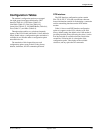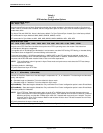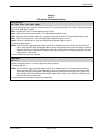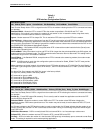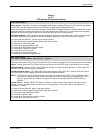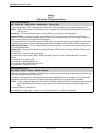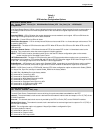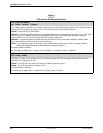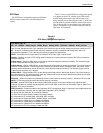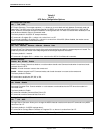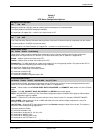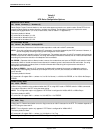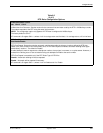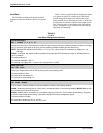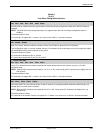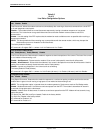
Configure Branch
9-153810-A2-GB30-30 September 1998
DTE Dialer
The DTE Dialer configuration options establish the
DTE-to-modem protocol for call establishment and
control.
Table 9-2 shows each DTE Dialer configuration option
as it appears on the LCD, with the Async Dial factory
default setting (the default value if the modem is just
being installed) shown following the colon (:) on the first
line and with all available selections listed on the second
line. Following this is a description of the configuration
option, a description of the available selections, and any
equivalent AT commands.
Table 9-2
(1 of 5)
DTE Dialer Configuration Options
DTE Dialer Type: AT
Nxt AT Disable V25bis_Async V25bis_Bsync V25bis_HDLC DTR=Dirs RS366A AT&T_Exclusv
Data Terminal Equipment Dialer Type. Identifies to the modem the type of dialing method and protocol used by the DTE.
AT – Allows AT command protocol to be used as a method for entering commands and dialing when used in an
asynchronous application. This is the only valid setting for leased-line applications.
NOTE: The modem will not respond to AT commands if DTE Dialer Type is not set for AT.
Disable – Disables any type of DTE dialing method. Dialing can only be performed using the DCP’s Dial command or
attached telephone.
V.25bis Async – Selects V.25bis Async as the dialing method and protocol used by the modem. The character length
must be 7 data bits with even parity and 1 stop bit.
V.25bis Bisync – Selects V.25bis Bisync as the dialing method and protocol used by the modem. This is also known as
character-oriented protocol. This framing protocol uses two synchronous control characters and a start-of-text control
character before the text block and an end-of-text control character after the text block. The character length must be
7 data bits with odd parity and 1 stop bit.
V.25bis HDLC – Selects V.25bis HDLC as the dialing method and protocol used by the modem. This is also known as
bit-oriented protocol. This framing protocol uses flag, address and control characters before the text block and a frame
sequence check and flag after the text block.
DTR=Dirs – Allows the modem to automatically dial the number stored in directory location 1 whenever DTR turns ON.
NOTE: DTR dialing cannot be used if dial access security is enabled.
RS-366A – Selects EIA RS-366-A as the dialing method and protocol; used (and available) only with Model 3811
modems. RS-366-A is a parallel interface typically used in older IBMr synchronous environments. Refer to Table E-4 in
Appendix E for pinout information.
AT&T Exclusive – Enables a subset of the proprietary AT&T command set, which is required for some applications that
use AT&T equipment. Currently, the only application supported is AT&T DATAKIT.
For Async Dial and UNIX Dial, AT is the factory default.
For Sync Dial and Sync Leased, Disable is the factory default.
AT commands for AT are &M0, &M1, &M3, &Q0, &Q1, and &Q3.
AT commands for Disable are &M231, &M236, &Q231, and &Q236.
AT commands for V.25bis Async are &M232 and &Q232.
AT commands for V.25bis Bisync are &M233 and &Q233.
AT commands for V.25bis HDLC are &M234 and &Q234.
AT commands for DTR=Dirs dialing are &M2 and &Q2.



